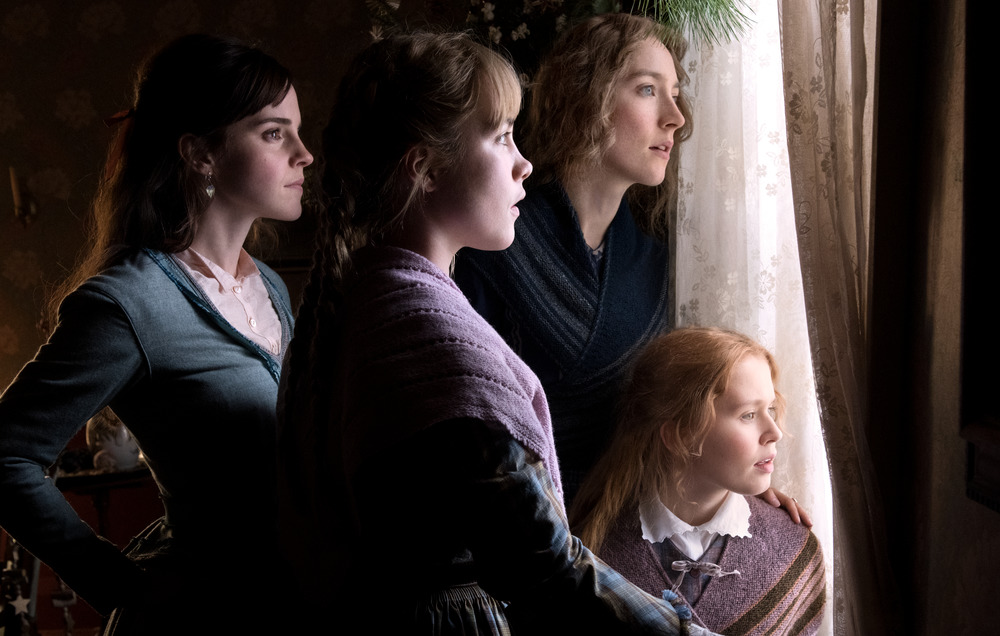Guest Post by Sarah Rebell
Which March sister are you?
The Internet is full of online quizzes asking that question, and promising to tell you whether you’re more of a reliable Meg or a headstrong Jo or an angelic Beth or a spoiled Amy, based upon your favorite ice cream flavor topping or your ideal travel destination. Buzzfeed has multiple quizzes, but so do more literary minded websites, ranging from the Oxford University Press to The Guardian to PBS. These quizzes promise to label the quiz-taker in the same simplistic way that they have labeled, and accordingly diminished, the four nuanced sisters from Louisa May Alcott’s novel “Little Women.”
“Little Women” frenzy has recently reached new heights in pop culture, thanks to Greta Gerwig’s 2019 adaptation of the classic story. The film is nominated for six awards at Sunday’s Oscars, including Best Picture. But the woman who conceived this film was not recognized with a nomination for Best Director.
Gillian Armstrong’s 1994 version of “Little Women” grossed over $5 million at the box office in its first weekend (over $9 million in today’s money), and the 2019 Gerwig version grossed over $16 million in its first weekend. Both earned strong reviews. How can the Academy continually ignore the women behind the “Little Women” adaptations, particularly when they create lucrative and critically acclaimed films? This stance reflects a larger social ambivalence towards successful women; it’s easier for society to label women than to praise them for their ambition and achievements.
Ever since “Little Women” was published in 1868, critics struggled to view the March sisters as fully actualized young women, instead of dolls to typecast. Over time, even the novel’s innovative characterizations became glossed over, as readers began to view “Little Woman” as a wholesome story for little girls, cloaked in sentiment and nostalgia. The simplified perception of the four March daughters was reinforced by early film adaptations in the mid-20th century. It wasn’t until Armstrong’s “Little Women” that the four title characters were presented in a more true-to-life, nuanced manner. Since then, critics had to reconcile the prim, stereotypical notions of “Little Women” that permeate the zeitgeist with the reality of the four individuals at the heart of Alcott’s story.
But, for decades, film adaptations of “Little Women” contributed to the misconception of the March sisters, Jo included. The first major sound version of “Little Women” came out in 1933, and starred Katharine Hepburn as Jo. In its review, Variety referred to the March girls as “a household of nineteenth-century girls moving quietly to ladylike maturity.” Mordaunt Hall of The New York Times proclaimed Jo to be “the personification of sincerity,” going so far as to add that “vice is unknown to her.” In actuality, far from quietly moving towards maturity, Jo March pushes back, doggedly and angrily, against the societal conventions forced upon the women of her era. She does not view herself as free from vice; she struggles to be good, whatever that means, and to contain her fierce temper.
Sixteen years later, when the first colorized “Little Women” came out the reviews still simplified the March sisters, unable to take their ambitions seriously, or to view them as individuals with their own complex personalities. The New York Times’ Bosley Crowther described the four young women as “sprightly and sentimental sisters” who will appeal to those who “have a sweet tooth.”
Forty-five years after that, when reviewing the 1994 adaptation, Roger Ebert seemed almost surprised to discover that “the buried issues in the story are quite modern.” In what might have passed for a “quite modern” vein, Ebert referred to Jo as “the tomboy” who “wants to be a writer,” at least acknowledging that her professional ambitions extend beyond the domestic sphere of home, hearth, and family. It’s not exactly a coincidence that the first “Little Women” movie with a female director was the first one to highlight Jo’s ambition and some of the proto-feminist themes deep within the book.
Although Janet Maslin of the Times declared, also in 1994, that “Little Women” was “the most innocent movie in town,” she, too, acknowledged how Jo was “intellectually ambitious.” The March sisters still appeared to her to be “fresh-faced teen-agers” but these teens weren’t passive and sentimental; they showed they had the capacity to “take-charge” (Jo) and be full of “twinkling mischief” (Amy). And this time, Variety called the March sisters a group of “spirited girls,” without any claims of the sisters “quietly moving” towards “ladylike” adulthood, as the publication had stated back in 1933.
Clare Niederpruem’s 2018 version was the first ever to be set in contemporary times, and the reviews were mixed. Nell Minnow of RogerEbert.com described it as “a modern-day retelling with a quartet of appealing young actresses, adapted with skill and understanding.” But it’s never a good sign when Variety describes a feature film as “Hallmark Channel-adjacent.” The young women who had been called “spirited” by Variety in 1994 were now, in the words of The Hollywood Reporter, “Alcott’s 19th century naifs,” as if these characters were so totally void of an identity that they needed the mention of their creator to prop them up.
The critics, scholars, and journalists who have written about the most recent “Little Women” films have been aware of the anger brimming beneath the story’s surface. They rejected the wholesomeness of the story that the earlier adaptations had praised, determined to prove that the Jo, Meg, Beth, and Amy’s world was more than one of mere sentimentality.
Although male critics wrote the vast majority of “Little Women” film reviews that I found from publications prior to the 21st-century, the Gerwig adaptation benefited from a discerning female gaze both behind the camera and in the reviews. The number of male and female writers penning articles about Niederpruem and Gerwig’s versions of the story was much more evenly split, nearly 50-50. Granted, publications are more likely to assign their female writers to cover a film that has long been considered a story primarily for girls, but, even so, the increase of women writers at these publications is evident. And while some early female critics appeared to view the March sisters with a hint of condescension, the majority of contemporary female writers have challenged previous notions of who the so-called little women truly are.
These contemporary critics, both men and women, have made much of Jo as an “ink-stained scribbler” (The New York Times) with “ink-stained fingers” (THR) in Gerwig’s “Little Women”; The Hollywood Reporter also asserted that “Jo’s emergence as a writer” is crucial to Gerwig’s entire interpretation. Kenneth Turan of the Los Angeles Times considered Jo to be “a whirlwind combination of eagerness, intelligence, uncertainty, and determination” in a film about how hard it is for “even gifted and intrepid women to succeed” in this world. Even Variety’s Peter Debruge, who describes the story as “a wholesome, kindhearted tale of generosity and good manners,” concedes that Alcott made the March sisters “independent-minded young ladies.”
Gerwig herself told The New York Times that the sisters were “four really talented weirdo girls who were ambitious and funny and competitive and kind of crazy.” No longer “naifs,” the March sisters in her film are now, according to THR, a “noisy brood” that possesses a “volatile mix of high spirits, camaraderie, and jealousy.” These fully realized sisters know just as much about anger as they do about sentimentality. As The New Yorker’s Anthony Lane wrote, “many a pinch and punch are delivered by the March clan.”
The anger does not begin and end with the four March sisters. In the book, their mother, Marmee, admits to Jo that she has been angry every day of her life. Gerwig’s film is the first to include that line from novel. Furthermore, her film doesn’t try to “minimize or apologize for that anger,” as The NY Times’ A.O. Scott pointed out. In an essay for The New Yorker, Sarah Blackwood suggested that Gerwig’s interpretation reveals what “Marmee and the girls might be angry about.” Despite their talents and ambitions as writer (Jo), performer (Meg), artist (Amy), and pianist (Beth), “the explosive potential of these four girls is not, and will not be, realized.” And in The NY Times, Amanda Hess stated that the March women are “trapped by history.”
But it’s not all in the past. “Little Women” reminds us that it’s not a given that women will be seen as fully dimensional human beings, entitled to strong emotions such as ambition and anger, in the workplace, in politics, in Hollywood, even in this new decade that has marked the rise of the#MeToo #TimesUp movements. Maybe the question we should be asking ourselves, in online quizzes and otherwise, isn’t “Which March sister are you?” but rather: Which trope of femininity has society labeled you as? And then, we might as well ask: Why does society think that women need to be labeled to fit a trope of femininity at all?
Sarah Rebell is an award-winning writer whose musicals include “The Awakening,” “Off the Wall,” and “Rose Petals.” As a theatrical journalist, her articles have been published by The Interval, The Dramatist, and Howlround. Rebell currently works at The Dramatists Guild of America.







